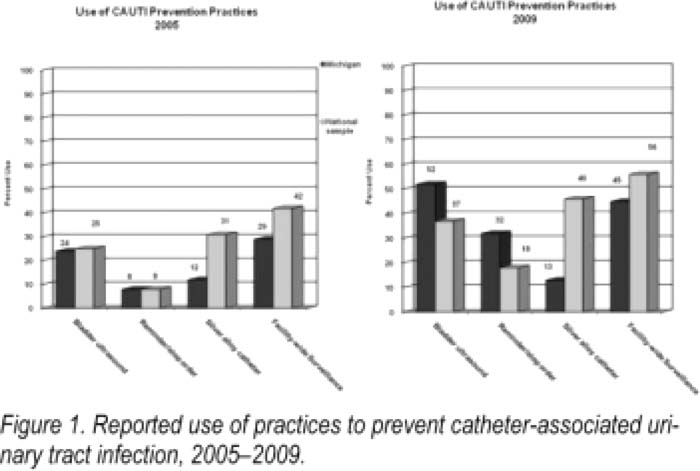Background:
Urinary catheters are frequently used in acute care settings, resulting in substantial morbidity and costs from catheter‐associated urinary tract infection (CAUTI). National data from 2005 revealed that preventing CAUTI was a low priority for most U.S. hospitals with little attention given to either CAUTI or urinary catheters as a patient safety problem. It is not known, however, whether the Centers for Medicare and Medicaid Services (CMS) policy to not pay hospitals for the costs incurred for hospital‐acquired CAUTI has increased use of prevention practices or whether additional strategies might be required. Therefore, we examined CAUTI prevention practices used by U.S, hospitals in 2005 and 2009 and compared a subset of hospitals in a state with a specific CAUTI prevention collaborative, Michigan, to the nationwide sample.
Methods:
Infection prevenlionists at general medical/surgical hospitals in Michigan (n = 100) and a national random sample of U.S. hospitals (n = 566) were surveyed in both 2005 and 2009 and asked about the use of practices to prevent CAUTI. We examined the percentage of hospitals reporting regular use of key practices in 2005 and 2009 and compared changes between Michigan hospitals and hospitals across the United States.
Results:
The response rale in both years was 70% or greater. Between 2005 and 2009 the percentage of hospitals reporting use of several practices to prevent CAUTI increased (Fig. 1). Increases were reported in the use of portable bladder ultrasound and facility‐wide surveillance for monitoring UTI both in Michigan and nationwide. Significantly more Michigan hospitals, however, reported using a catheter reminder or stop order in 2009 compared to other hospitals in the United States (32% vs. 18%), whereas the reported use of silver alloy catheters was much greater by hospitals outside Michigan (13% Michigan vs. 46% elsewhere). Sixty‐eight percent of hospitals in Michigan and 64% across The United States reported a moderate to large increase in prevention of CAUTI as a priority because of payment changes; however, the use of most evidence‐based prevention practices was reported by fewer than half of The hospitals in both samples.
Conclusions:
Since 2005, there have been increases in the percentage of hospitals — in Michigan and across the United States — reporting the use of several practices to prevent CAUTI. However, there are some notable differences in the types of practices used, with Michigan hospitals using practices that focus more on reducing unnecessary catheter utilization, which may be a result of participation in a statewide CAUTI prevention collaborative. Although the majority of hospitals report a sizable increase in CAUTI prevention as a facility priority related to the CMS payment changes, the percentage using specific practices to prevent CAUTI remains low.
Author Disclosure:
S. Krein, none; C. Kowalski, none; M. Fakih, none; R. Olmsted, none; S. Saint, CR Bard, VHA Institute for Healthcare Improvement, honoraria.

